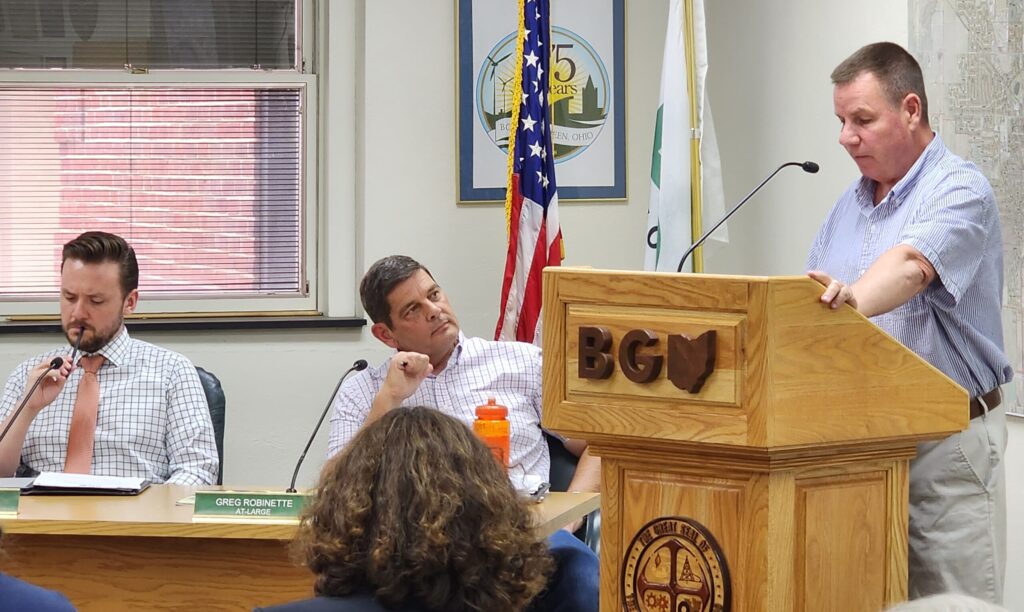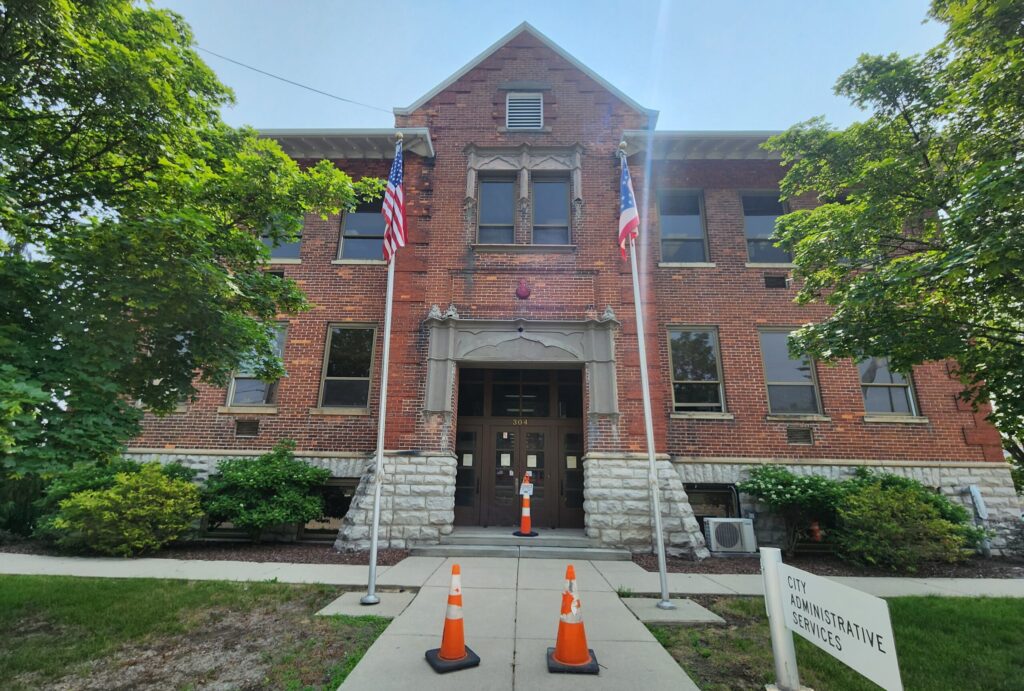By JAN LARSON McLAUGHLIN
BG Independent News
Bowling Green City Council bid farewell Thursday to their meeting place for nearly a half century.
Built in 1901, the Bowling Green city building spent its first 55 years as an elementary school, then 20 years as a library, and now 47 years as the city administration building.
“It’s my opinion the city has gotten its money’s worth out of this building,” Mayor Mike Aspacher said as he reflected on the structure’s history.
When the city took over the building in 1976, the mayor was Alvie Perkins, a plumber. As city officials prepare to move to their new site next door, the mayor is Aspacher, a retired plumber.
“It’s come full circle,” Aspacher said with a smile.

In the hallway outside council chambers, the white wall was covered with colorful handprints and signatures from former city employees saying goodbye. Underneath the hands was a note scrawled on the wall: “305 N. Main here we come. No writing on those walls. Haha. No seriously.”
Aspacher reflected on the era when the city building opened in 1976. Gerald Ford was president, the average annual income was $16,000, the average home price was $43,000, and the federal minimum wage was $2.30 an hour.
A brand new Ford Pinto sold for $2,895, while the classier Cordoba sold for $4,895. “I owned one of those,” the mayor added. Gas was 59 cents a gallon, and a Big Mac was 75 cents.
To anyone mistaking the reminiscing for a desire to stay in the old building, Aspacher made it perfectly clear.
“I’m excited to move to the new building,” the mayor said.

Municipal Administrator Lori Tretter noted the first piece of legislation to be passed by City Council in the building was to allow for the sale of the city’s used 1969 Cadillac ambulance.
She spoke of those who came before current city leaders, and of the thousands of public meetings held in council chambers.
“Many decisions about our community have been shaped here in this room,” Tretter said.
“Local government has more of the daily impact to people who live here,” she said. “The people are at the heart of our local government.”
“I’m finding myself a little sentimental,” but so ready to make the move to the new building, she said.
In the audience at Thursday’s meeting was former council member Joyce Kepke. As she left the meeting, she stood outside looking at the new building nearing completion. Kepke reflected that her first council meeting was in 1976 in the building nearing its demolition.
Long-time council member Bill Herald remarked on Bowling Green’s ability to handle growth while maintaining a small town atmosphere in the community.
“This city is well run and it has been for decades,” he said.
“It is time to say goodbye to this dear friend of a building,” Herald said.
The city building will be closed during the move to the new building on July 14 and 17. The new city administration building will be open 18. There will be no City Council meetings in July.
Members of the public are invited to a “sneak peek” of the new city building on Wednesday, July 12, from 3 to 6 p.m.
The parking lots will still need to be constructed, and the old building demolished. A ribbon cutting will be held when the site is complete, Tretter said.

The city building, at 304 N. Church St., started its life more than a century ago as a school. It then was turned into a library, and in 1976 became the city administration building. The result is a 17,000 square foot building with cramped offices, maze-like spaces and cobbled together technology.
After years of discussion, the solution was found right next door.
In 2017, city officials announced that property at 140 S. Grove St. would be donated to the Wood County Senior Center for a new facility. The new site would allow for a much larger senior center and for a building actually constructed for that purpose, instead of the retrofitted post office that had been used as a senior center for years.
The move from 305 N. Main St. to South Grove Street not only benefited local seniors, but it also freed up the space used as the senior center – which is right next to the city administration building. And that means the city had an entire stretch between North Main Street and North Church Street for a more spacious and modern city administration building.
The location also satisfied the desire of many to keep the city building in the downtown.
The city building has a long list of deficiencies, which staff can easily recite.
The council chambers is small, with the fire code allowing a maximum of 66 people. That means several times a year, citizens attending meetings have to stand in the hallway since the room is overflowing. The restrooms are cramped and just barely pass muster for handicapped accessibility.
Some office floors slope so much that wheeled chairs roll across the surface. Power access is less than ideal, so masses of cords are plugged into inconvenient locations. The old construction is not energy efficient, with the south side sweltering in the afternoon sun while the north side of the building is freezing.
The technology department is a maze of rooms, with one of the smallest housing the brains of the building – servers with information on email, telephones, utilities, finances, taxes and police data. Storage space is in great demand, with boxes and files filling any vacant space, behind doors, on floors, and stacked high on shelves.

